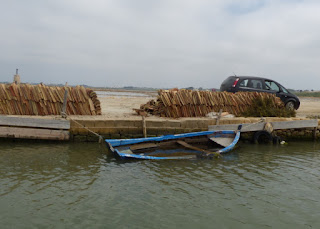We headed north along the coast and stopped in Marsala to go a working salt farm and museum. On our way, Isabella told us about new information (at least new to most of Italy), thanks to the availability of information from outside sources on the internet, about the unification of the country in the 1860s. Garibaldi is treated as a hero in the history books here and is said to have defeated a Sicilian force of 140,000 soldiers (double the peacetime number) with a force of 1,000. In that time, Sicily consisted of the island and most of Italy below Rome and was doing quite well. They had competent rulers and over a million dollars in the banks, all backed by gold. In the north, some of the provinces claimed to have $20 million, but it was all paper and there were bankers in other parts of Europe who looked greedily at the possibility of capturing the Sicilian wealth. They managed to bribe critical Sicilian generals to lay down their arms and basically destroyed much of what the Sicilians had built and killed a high proportion of the population. Sicilians, she said, are not looking to break away, but would like to have the record set straight and not be treated as lesser people by the north ("when a Sicilian counts, he says one, two, three, a lot").
The salt producers are still doing some of the work the old way with lots of back-breaking labor, but they are having a hard time keeping employees, so it is only a question of time until the whole process is mechanized, which will mean the end of their production of the 'flower of salt', the first top layer of salt that is hand skimmed and more interesting than other salts. They use windmills to move the salt water between successive ponds, each shallower and more salty than the last. As the salt concentrates, they use a hand tool to disturb or stir the salt in the ponds. When there is still a bit of water on top of the salt, they use a shovel that is like a fine metal net to lift the top layer of salt and water and let the water drain out before dumping the salt in a basket. When the salt is totally dry, they shovel it into cone shapes and then shovel the cones into wheel barrows to be dumped into a conveyor belt. In the past, they also used a windmill to grind the salt crystals between two huge stones, but that is done by other machines now.
 |
| Windmill move the salt water towards shore as salinity increases. |
 |
| This worker is 'stiring' the salt. |
They gave us samples of the flower of salt to taste, and it was very interesting. They also had several mixes of salt and flavors like lemon or orange or rosemary to use on different kinds of foods. These are all salts you would use at the table, not for cooking.
Then we hopped into a shallow draft boat to get to Mothya, and island first populated by the Phoenicians, who were later defeated by the Greeks. The island is in a shallow lagoon created by a long skinny outer island that protects the interior area. The water now is almost 2 feet deeper than it used to be, so some archeological finds are underwater, including the road the Phoenicians built to the mainland. We took the boat up to the old road and Isabella valiantly jumped out and walked on it - the water was about up to her ankles. She also found a live example of the mollusk that the Phoenicians used to create the purple dye they were famous for.
 |
| Ancient walls |
 |
| That rock is on one side of the submerged causeway. |
On the island, we visited a museum that featured a wonderful marble statue and a number of other artifacts from the Phoenician times. Then we walked about a mile past a couple of digs including an area with simple black & white mosaic floors as well as what is now believed to have been a temple.
 |
| The Youth of Mothya |
 |
| Reisdence |
 |
| Mosaic floor |
 |
| Above and below, two-story watch tower |
 |
| Temple area |
 |
| Pond in the temple area |
 |
| Neighboring island, Scuola. The builing was an insane asylum |
 |
Another salt farm on Isola Longa, the barrier island that created
the lagoon we are in. |
After a picnic lunch, we headed back to the mainland and continued north to a winery, Baglio Oro. In addition to wine, they also have two jewelry shops, hence the 'oro' (gold) in their name. In the past, they were primarily growers and then made several white and red wines. However, in the last 5 years, they have also started to produce fine quality marsalas (not like the stuff you cook with). These fortified (hard alcohol added) wines can be dry or sweet. The dry ones need to be aged longer than they have had time for, so the dry one came from another winery. We tried a dry white called Inzolia, a red Nero d'Avola, their new sweet marsala, and a dry marsala. The nero was terrific and we bought a bottle. They also distribute to the San Francisco area, so we gave them our card and their distributor there will let us know where we can find it. It will be interesting seeing how much it costs at home vs. here in Sicily!
Tomorrow we move to an agritourismo place for a single night's stay. Hard to believe our first week here is almost over!























No comments:
Post a Comment